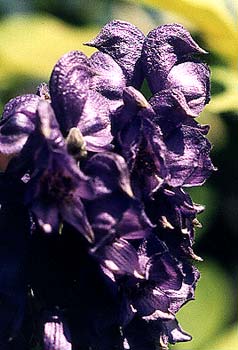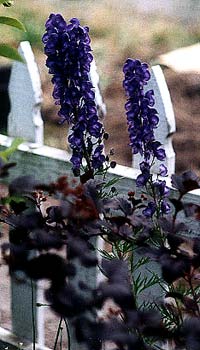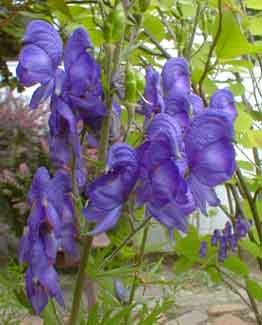
'Newry Blue' Monkshood
aka Friar's Cap
aka Wolfsbane
aka Helmet Flower
aka Soldier's Cap
"No, no! go not to Lethe, neither twist
Wolf's-bane, tight-rooted, for its poisonous wine;
Nor suffer thy pale forehead to be kist
By nightshade, ruby grape of Proserpine."
-John Keats
1795‚1821
1795‚1821
Monkshood is not merely named for the flowers' resemblance to monks' cowls, but for the greater resemblance to the war helmets of knights who took monks' vows before riding fully armored to the Crusades, hence its alternate names Soldier's Cap or Helmet Flower. It's also called Wolfsbane because it was used in the Dark Ages to poison meat left out to kill wolves. It is blessed with so many wonderful folk-names. Some old English names include Captain-Over-the-Garden, Chariot-&-Horses, Granny's Nightcap, Auld Wife's Huid, & Lucky's Mutch.
 The monkshood shown on this page is among the darkest purple-blue of several species & cultivars that we have. It was four feet tall its second year in our yard, five feet thereafter, when the flower spike is present. It generally has a stalk substantial enough that it need not be staked to remain upright. Ours leans a little, but only so for the sake of sunlight, not from weakness of the stems.
The monkshood shown on this page is among the darkest purple-blue of several species & cultivars that we have. It was four feet tall its second year in our yard, five feet thereafter, when the flower spike is present. It generally has a stalk substantial enough that it need not be staked to remain upright. Ours leans a little, but only so for the sake of sunlight, not from weakness of the stems.This one is also more strongly a spike of dense flowers than most of the monkshoods in our gardens. Many of the others have a looser structure to the way the blossoms are held. This dark variety is 'Newry Blue,' which is known for these denser spires. Though it is primarily Aconitum napellus (the common European monkshood), it has in its hybridization history a bit of A. cammarum (Bicolor Monkshood), hence is sometimes marketed as A. x bicolor 'Newry Blue.' A pure A. nepellus has the looser-flowered spike. There's a separate European Monkshood Page if you'd care to compare the difference.
Cut flowers last a long time in floral arrangements. Though it prefers a little shade, this bright blue one has adapted to a lot of afternoon sun, with just a little protection given to it by surrounding plants, in particular by the Diablo Ninebark beside it.
 Every part of this plant is poisonous, & should not be handled roughly enough to get any of its juices in a gardening wound. The specific toxin is aconitine & it is most concentrated in the root, but the whole plant should be handled with care. The same toxin is found in delphiniums but not in such dangerous concentrations.
Every part of this plant is poisonous, & should not be handled roughly enough to get any of its juices in a gardening wound. The specific toxin is aconitine & it is most concentrated in the root, but the whole plant should be handled with care. The same toxin is found in delphiniums but not in such dangerous concentrations.In the ancient world, soldier's used monkshood poison for the tips of spears. In India it was used to poison arrows. When Hamlet faced Laertes in a duel, Laertes had covered his blade in juices from monkshood. Throughout the ancient world, more than one throne changed buttocks thanks to the machinations of court poisoners. This is the reason why in Rome it was banned from cultivation, under penalty of death.
Pliny thought monkshood could negate the effects of scorpion poison or snakebite. From Pliny's day until the 18th Century, attempts were made to find correct doses for medicinal purposes, but it was just never safe enough, & its use tended to be restricted to topical application as a pain reliever. Mainly, outside of Chinese & Tibetan medicine, & the magic-based alchemy of quackpot homeopaths, monkshood simply never made it into the legitimate herbal pharmacopeia, but was much more associated with the blends of sorcerers & witches.
Sundry varieties have slightly different bloom times, but roughly speaking 'Newry Blue' blooms June & July. As a generality A. napellus blooms a bit earlier than other monkshood species (in some people's gardens the species will bloom as early as March), & may rebloom before Autumn's first frosts, typically in August if deadheaded before seeding. In our garden, three clumps of blue monkshoods start off the monkshood season, & the last to bloom will be autumn-flowering A. carmichaelii.
When 'Newry Blue' goes to seed, the seed pods look like upside-down three-legged bloomers or cuttlefish. If these are removed while still green, it is more likely the monkshood will rebloom in late August or September.
I use antique wooden darning needles or Chinese chopsticks to mark the sites of perennials that die back entirely, so that I won't accidentally dig them up or plant something else on top of them before they reappear in spring. In winter, monkshood disappears utterly, but will grow back bigger than before.
'Eleanor' Bicolor Monkshood
which discusses the specifics of the toxicity of the whole genus.